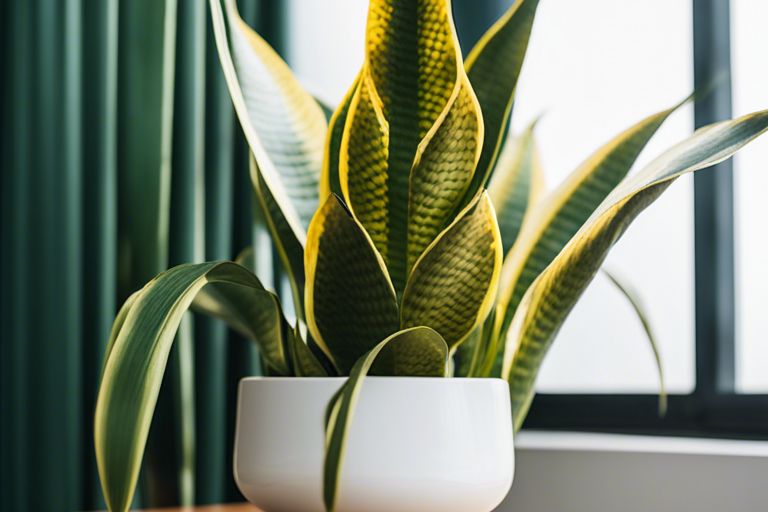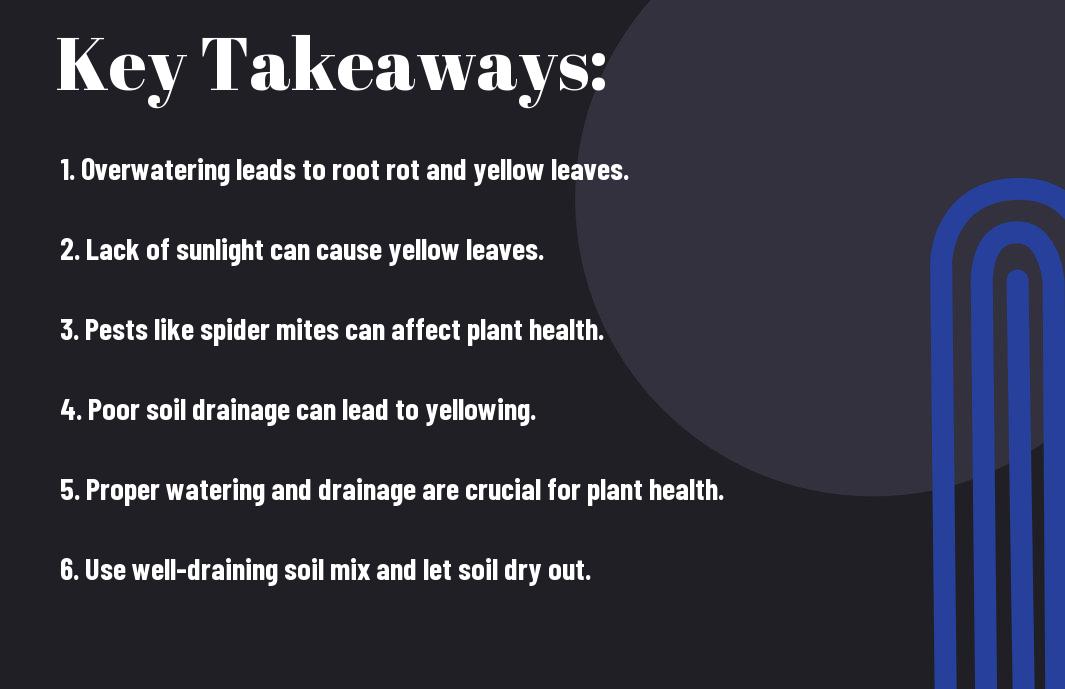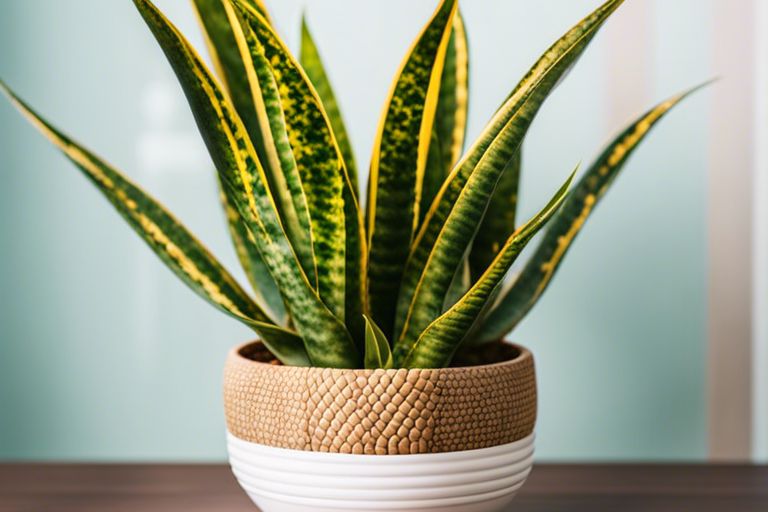Just discovered your prized snake plant’s leaves turning yellow? Don’t panic, but take action. Yellowing leaves on a snake plant can be a sign of distress, and understanding the root causes is crucial to restoring your plant’s health. In this blog post, we will examine into the various reasons behind yellowing snake plant leaves and provide you with effective solutions to address the issue.
Key Takeaways:
- Overwatering: Excess water can lead to root rot, causing snake plant leaves to turn yellow. Make sure the soil has good drainage and only water when the top inch is dry.
- Low Light: Insufficient light can also cause snake plant leaves to yellow. Place your plant in a spot with bright, indirect light to promote healthy growth.
- Pest Infestation: Check for pests like spider mites or mealybugs that can cause yellowing leaves. Treat the infestation with neem oil or insecticidal soap to restore the plant’s health.
The Science of Leaf Coloration in Snake Plants
Now, let’s examine into the fascinating world of snake plant leaf coloration. Understanding the science behind why snake plant leaves turn yellow can help snake plant owners effectively care for their plants.
Chlorophyll and Its Role in Leaf Color
On a cellular level, chlorophyll is the pigment responsible for the green color of snake plant leaves. Chlorophyll plays a crucial role in photosynthesis, the process by which plants convert sunlight into energy. When a snake plant is healthy and receiving adequate light, chlorophyll production is optimal, resulting in vibrant green leaves.
Other Pigments and Their Contributions
Contributions from other pigments in snake plants can lead to variations in leaf color. While chlorophyll dominates and masks other pigments in healthy leaves, certain conditions can cause these other pigments to become more prominent, resulting in yellow or reddish hues. For instance, a lack of sunlight or overwatering can lead to a decrease in chlorophyll production, allowing other pigments to show through and causing yellowing of the leaves.
Common Causes of Yellowing Leaves in Snake Plants
Natural Aging Process
Not sure why your snake plant leaves are turning yellow? It’s imperative to understand that the natural aging process of snake plants can cause lower leaves to yellow and die off. This process is normal, and you may notice the older leaves turning yellow and eventually drying up and falling off. If you’re concerned about the yellowing leaves on your cylindrical snake plant, consider reading more about it 🐍 Why Are My Cylindrical Snake Plant Leaves Turning …
Watering Issues
Watering is another common cause of yellowing leaves in snake plants. Overwatering can lead to root rot, which impairs the plant’s ability to take up nutrients, causing the leaves to turn yellow. On the other hand, underwatering can also cause yellowing leaves, as the plant is not receiving enough moisture to sustain healthy growth. If you suspect watering issues, make sure to adjust your watering schedule accordingly and check the soil moisture before watering.
Understanding the specific watering needs of your snake plant is crucial for maintaining its health. Ensure that you allow the soil to dry out between waterings to prevent overwatering, but don’t let it completely dry out, as this can lead to dehydration and yellowing leaves.
Light Conditions
On top of that, inadequate light conditions can also result in yellowing leaves. Snake plants prefer bright, indirect light, and if they are not receiving enough light, they may start to show signs of stress by yellowing. Placing your snake plant in a well-lit area away from direct sunlight can help prevent yellowing leaves due to insufficient light.
With proper light exposure, your snake plant can thrive and maintain its vibrant green color. Consider rotating your plant occasionally to ensure all sides receive adequate light for even growth and development.
Nutrient Deficiencies
Leaves turning yellow may also indicate nutrient deficiencies in your snake plant. Lack of imperative nutrients like nitrogen, potassium, or magnesium can lead to yellowing leaves and overall poor plant health. Consider fertilizing your snake plant with a balanced houseplant fertilizer to ensure it receives the necessary nutrients for optimal growth.
A balanced fertilizer specifically formulated for indoor plants can help address any nutrient deficiencies and support the overall health of your snake plant. Remember to follow the instructions on the fertilizer package to avoid over-fertilizing, which can also cause yellowing leaves.
Temperature Stress
| Extreme temperatures can also stress snake plants, leading to yellowing leaves. Exposure to cold drafts or sudden temperature changes can cause shock to the plant, resulting in yellowing leaves. |
It’s important to maintain consistent temperatures around your snake plant and avoid placing it near heaters, air conditioning vents, or drafty areas to prevent temperature-related stress and leaf yellowing.
Pests and Diseases
Leaves turning yellow could also be a sign of pest infestation or disease affecting your snake plant. Common pests like spider mites, mealybugs, or fungal infections can cause yellow spots or patches on the leaves. Inspect your plant regularly for any signs of pests or diseases, and take appropriate measures to treat and prevent further damage.
This proactive approach can help protect your snake plant from potential threats and ensure its continued health and vitality. If you notice any unusual yellowing or discoloration on your plant’s leaves, investigate further to identify the underlying cause and address it promptly.
Diagnostic Tools and Techniques
Visual Inspection
Many times, the first step in diagnosing why snake plant leaves are turning yellow is through visual inspection. Inspect the plant for any signs of pest infestation, overwatering, underwatering, or other environmental stressors that could be causing the issue. Look for yellowing leaves, brown tips, spots, or any unusual growth patterns.
Soil Testing
For more in-depth analysis, soil testing can help determine if the plant is lacking vital nutrients or if the soil pH levels are off. You can use a soil testing kit to check the pH levels, nutrient levels, and moisture content of the soil. This information can guide you in adjusting your plant care routine to meet the specific needs of your snake plant.
Understanding the importance of soil testing is crucial in maintaining the health of your snake plant. By identifying any nutrient deficiencies or soil imbalances early on, you can take proactive measures to correct the issues and prevent further yellowing of the leaves.
Leaf Tissue Analysis
Diagnostic leaf tissue analysis is a more advanced technique that involves sending leaf samples to a laboratory for analysis. This method can provide detailed information on the plant’s nutrient levels, mineral composition, and overall health status. The results can help pinpoint the exact cause of yellowing leaves and guide you in creating a targeted treatment plan.
Soil and leaf tissue analysis are valuable tools in determining the underlying causes of yellowing snake plant leaves. By utilizing these diagnostic techniques, you can effectively address the issues affecting your plant’s health and promote vibrant, green foliage.
Preventative Measures for Healthy Snake Plants
Adequate Watering Practices
Your snake plant will thrive with proper watering practices. Healthy snake plants prefer dry conditions, so it’s crucial not to overwater them. Make sure the soil is completely dry before watering again. During the growing season, water sparingly, while in winter, reduce watering even more. Always use well-draining soil to prevent water accumulation, which can lead to root rot and yellowing leaves.
Optimal Lighting Conditions
Measures should be taken to provide your snake plant with the right amount of light. Snake plants are known for their resilience in low-light conditions, but this doesn’t mean they thrive in darkness. Place your plant in a location where it receives indirect, adequate sunlight. Rotate the plant occasionally to ensure even growth on all sides.
Preventative actions such as providing the right lighting conditions can help prevent yellowing leaves and ensure the overall health of your snake plant.
Proper Fertilization Routines
Healthy snake plants benefit from a proper fertilization schedule. For instance, using a balanced houseplant fertilizer diluted to half-strength every 2-4 weeks during the growing season can support growth. Remember to withhold fertilizer during the dormant winter period to give your snake plant a rest.
Adequate fertilization practices can enhance the vitality of your snake plant and contribute to its overall well-being.
Temperature Control
| Optimal Temperature | Impact on Snake Plant |
| 60-85°F (15-29°C) | Healthy growth and development |
Optimal temperature control is crucial for the health of your snake plant. Snake plants thrive in temperatures between 60-85°F (15-29°C). Ensure to protect your plant from drafty areas or sudden temperature fluctuations, as this can stress the plant and lead to issues like yellowing leaves.
Regular Monitoring and Maintenance
Practices such as regular monitoring and maintenance play a vital role in keeping your snake plant healthy. Check the leaves periodically for any signs of distress, pests, or diseases. Trim off any yellow leaves promptly to prevent further issues and maintain the plant’s aesthetics.
Adequate attention to monitoring and maintenance can help you address any problems early and keep your snake plant thriving.
Treatment Methods for Yellowing Leaves
Adjusting Watering Habits
An important step after noticing yellowing leaves on your snake plant is to assess your watering habits. Overwatering is a common cause of yellow leaves, as it can lead to root rot. Allow the top few inches of soil to dry out before watering, and always ensure proper drainage to prevent water from pooling at the bottom of the pot.
Balancing Light Exposure
One factor that is often overlooked in the care of snake plants is light exposure. Too much direct sunlight can scorch the leaves, causing them to yellow and burn. On the other hand, insufficient light can also lead to discoloration. Find a balance by placing your plant in a spot with bright, indirect light.
To prevent further damage, consider rotating your snake plant occasionally to ensure all sides receive even exposure to sunlight. This will help promote balanced growth and reduce the risk of yellowing leaves.
Correcting Nutrient Imbalances
To address yellowing leaves caused by nutrient imbalances, it is important to first identify the specific deficiency or excess. Common nutrient deficiencies that result in yellowing leaves include nitrogen, potassium, and iron. Consider using a balanced fertilizer specifically formulated for indoor plants to provide the necessary nutrients.
Treatment with a slow-release fertilizer can help gradually correct these imbalances and promote healthy foliage growth. Remember to follow the instructions on the fertilizer package carefully to avoid over-fertilization, which can also harm your snake plant.
Pest and Disease Management
Leaves turning yellow can also be a sign of pest infestation or disease. Inspect your plant carefully for signs of common pests such as mealybugs, spider mites, or scale insects. Treat any infestations promptly with an appropriate insecticidal soap or neem oil solution.
Leaves that are yellowing due to disease may need to be trimmed to prevent the spread of the infection. Remove affected leaves using sterile pruning tools and be sure to dispose of them properly to avoid contaminating other plants.
When to Prune or Remove Affected Leaves
A regular inspection of your snake plant is crucial to catch yellowing leaves early. Light pruning can help remove damaged or diseased foliage, allowing the plant to focus its energy on healthy growth. Trim yellow leaves down to the base using clean shears to maintain the plant’s overall appearance.
The key is to prune conservatively and only remove leaves that are severely yellow or damaged beyond repair. Take care not to over-prune, as this can stress the plant and slow its recovery process.
When to Seek Professional Help
Despite your best efforts, if your snake plant continues to struggle and show signs of distress, it may be time to seek professional help. This can be a wise choice when you have tried various remedies but the yellowing of the leaves persists. Consulting with a plant care specialist or a professional gardener can help you identify the underlying issue and find a solution to save your plant.
Persistent Problems Despite Treatment
To address persistent problems with your snake plant despite treatment, seek guidance from a professional who can offer personalized advice. They may conduct a thorough assessment of your plant’s environment, including lighting, watering, and soil conditions, to pinpoint the exact cause of the yellowing leaves. With their expertise, they can recommend tailored solutions to revive your plant and promote its overall health.
Identifying Serious Plant Diseases
Any signs of serious plant diseases on your snake plant should not be ignored, as they can quickly spread and threaten the wellbeing of your entire plant collection. If you suspect your snake plant is affected by a severe disease, it is crucial to seek professional help promptly. Experienced professionals can accurately diagnose the issue and recommend appropriate treatment measures to prevent further damage.
Plus, professional assistance can help you mitigate the risk of other plants in your home getting infected, as certain plant diseases can be contagious and easily transmitted. Acting swiftly and decisively with the guidance of a plant care expert is key to safeguarding the health of your snake plant and maintaining a thriving indoor garden.
Accessing Expert Assessment and Advice
Advice from a knowledgeable plant care specialist can be invaluable when dealing with complex issues affecting your snake plant. Expert assessment and advice can provide you with a comprehensive understanding of the problem at hand, along with practical strategies to address it effectively. By seeking professional help, you can tap into a wealth of botanical knowledge and experience to nurture your plant back to optimal health.
Seeking professional assistance is recommended when you face challenges with your snake plant that require specialized expertise beyond your current know-how. The insights and recommendations provided by a plant care professional can make a significant difference in resolving issues and ensuring the long-term vitality of your beloved plant. Do not forget, it’s always better to seek help sooner rather than later to give your snake plant the best chance at thriving.
Conclusion
With these considerations in mind, it is clear that yellowing snake plant leaves can be caused by a variety of factors such as overwatering, underwatering, improper lighting, or pests. By understanding these causes, plant owners can take the necessary steps to address the issue and prevent further damage to their snake plants.
Implementing proper watering practices, ensuring adequate sunlight, and regularly inspecting plants for pests are vital in maintaining the health of snake plants. By following these guidelines and promptly addressing any issues that arise, plant owners can enjoy thriving snake plants with vibrant green leaves for years to come.



